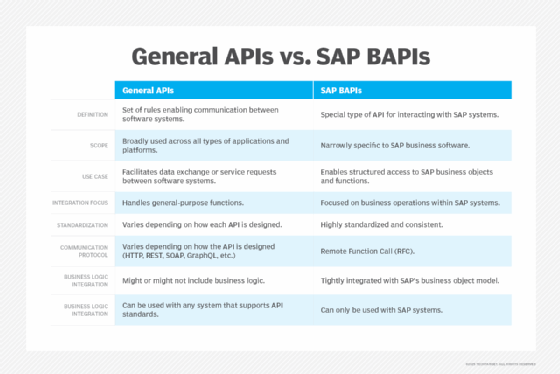What is SAP BAPI (Business Application Programming Interface)?
SAP BAPI (Business Application Programming Interface) is a special type of application programming interface (API) that allows third-party software applications to interact with SAP systems. Instead of writing custom code for every integration, third-party developers can query SAP's Business Object Repository (BOR) and use a predefined BAPI to perform a business function within an SAP system.
SAP developed BAPIs to expose SAP business logic in a standardized way that reduces the complexity of connecting external software platforms with SAP ERP systems. Each BAPI uses the same naming conventions, follows a similarly structured format and can be called using SAP's proprietary Remote Function Call (RFC) protocol.
Importance of SAP BAPIs
SAP BAPIs are important because they standardize how external applications access and interact with business objects and business processes within SAP systems. The standardization allows developers to create applications that can safely and reliably interact with SAP business processes without needing to understand the underlying SAP system's logic or internal implementation details.
BAPIs follow the same business logic as actions performed manually through an SAP system graphical user interface (GUI). This ensures that transactions conducted programmatically use the same data validation, authorization checks and business rules as transactions executed by end users within the SAP interface.
Because BAPIs enforce SAP's process controls, they help ensure compliance with business policies and reduce the risk of inconsistent or unauthorized system behavior. This is a major reason BAPIs are trusted over lower-level access methods like direct table access.
How SAP BAPIs work
BAPIs are implemented as remote function modules written in Advanced Business Application Programming (ABAP), which is SAP's proprietary programming language. Each BAPI is tied to a specific SAP business object that represents a real-world business entity, such as a customer or sales order.
In SAP systems, business objects consist of attributes (data) and methods (operations that can be performed on that data). Essentially, BAPIs standardize the way external applications request operations to be performed on SAP business objects.
When a BAPI is called, it sends structured input data to the SAP system, executes the business logic encapsulated in the corresponding business object method and receives the results (and status information) in a consistent format. Any development platform that supports SAP's RFC protocol can use BAPIs to access and interact with an SAP system.
Here is how the process might work step by step:
- The developer searches SAP's Business Object Repository for a BAPI that matches the business task they want to perform (like creating a sales order or reading customer data).
- The developer reviews the BAPI to determine which input fields are required, optional or conditionally required.
- The developer uses an SAP-supported connector (like SAP JCo for Java or SAP NCo for .NET) to connect their external application to the SAP system using the RFC protocol.
- The developer formats the data to match the BAPI's input structure. This usually involves filling in tables or structured fields exactly as defined in the BAPI documentation.
- The developer uses the connector to write code that calls the BAPI function remotely and sends the input data to the SAP system.
- The developer reads the output from the BAPI. This might include operation results (like a newly created sales order number) and a RETURN table with success or error messages.
- Based on the response, the developer builds logic to display results, retry on failure or log error messages for debugging.
Types of SAP BAPIs
SAP does not officially recognize different types of BAPIs, but software developers often categorize them to improve communication during planning meetings. Basically, categorization allows everyone on the development team to quickly understand the purpose of each BAPI and align technical decisions with business requirements.
In some organizations, BAPIs might be categorized by the business operation they support:
- Creation BAPIs. These are used to create new instances of business objects (e.g., BAPI_CUSTOMER_CREATEFROMDATA1).
- Change BAPIs. They modify existing business objects (e.g., BAPI_MATERIAL_SAVEDATA).
- Read BAPIs. They retrieve detailed information about a specific business object (e.g., BAPI_CUSTOMER_GETDETAIL).
- Delete BAPIs. These BAPIs deactivate or flag objects for deletion (true physical deletion is uncommon in SAP, due to audit and traceability requirements).
- Transaction BAPIs. They manage complete business transactions and typically include support for commit and rollback control.
- Query BAPIs. They return lists or collections of business object instances based on selection criteria.
In other organizations, developers might categorize BAPIs by their structural relationship to SAP business objects.
- Business object BAPIs. These are tied to SAP business objects in the SAP Business Object Repository. They are used for standard operations like create, read, update or delete (CRUD).
- Interface BAPIs. These are a special kind of BAPI that allows an SAP system to send data to a third-party application. This type of BAPI is typically used for asynchronous outbound communications.
SAP BAPI uses
SAP BAPIs are widely used in enterprise environments to enable backend system-to-system integration. (System-to-system integration refers to the automated exchange of data and functionality between two or more independent software systems.) For example, a customer order created in a third-party e-commerce platform might use a BAPI to automatically trigger a sales order in SAP's ERP system.
Other common use cases for SAP BAPIs include:
Data migration and bulk uploads. SAP BAPIs can be used to load large volumes of data into SAP systems safely, cleanly and reliably. Because BAPIs enforce SAP's internal business logic and data validation rules, they ensure data integrity and prevent invalid or corrupt data from entering the system.
Master data management. BAPIs are often used to synchronize master data between SAP and non-SAP systems so that both systems provide the same view of data.
Financial postings. SAP BAPIs can be used to automate the creation of invoices or payment requests from external financial applications.
Supply chain integration. BAPIs can connect SAP systems with external warehouse management systems (WMS) or transportation management systems (TMS) to enable real-time inventory updates and logistics processes.
Human resources (HR) processes. SAP BAPIs are often used to integrate SAP HR modules with external payroll systems or employee self-service (ESS) portals.
Manufacturing operations. BAPIs can be used to automatically send or receive production orders and confirmations from manufacturing execution systems (MES).
Reporting and analytics. Read-only BAPIs can extract structured data from SAP systems for use in external business intelligence (BI) tools, dashboards or data warehouses without modifying core SAP data.
SAP BAPI features
One of the most important features of BAPIs is their standardized interface. Most BAPIs follow a common structure consisting of import parameters, export parameters, table parameters, and return parameters.
- Import parameters provide the data that the BAPI needs to execute its business process.
- Export parameters provide the results of the BAPI's execution.
- Table parameters allow multiple records of data to be used as input or output.
- Return parameters provide status information about the execution.
Some BAPIs might also include changing parameters. Changing parameters are parameters that a BAPI can read and modify during execution. While SAP supports changing parameters because they are a feature of the ABAP programming language, they are rarely used in practice because they blur the line between input and output.

APIs vs. BAPIs
An API is a set of rules that allows software programs to communicate with each other. APIs are useful because they make it possible for one software system to share data with another without needing to know how the other system works. Technically, an API defines what data can be requested, how to format the request and what kind of response to expect.
BAPIs are a special type of API for interacting specifically with SAP business software systems. In other words, all SAP BAPIs are APIs, but not all APIs are BAPIs.
The key difference is that BAPIs are tightly integrated with SAP's business objects. This means BAPIs will automatically enforce the same IT controls that SAP systems use when someone enters data manually into an SAP GUI.

When to use BAPIs
Developers can use both general APIs and BAPIs to access data in SAP systems. In general, BAPIs are a better choice for business-critical operations that prioritize data integrity and compliance with SAP's business logic.
It should be noted, however, that SAP is gradually modernizing its application architecture. Traditional BAPI functions in many newer systems, especially cloud-based systems, are now exposed as RESTful APIs delivered through OData services.
This newer approach aims to simplify integration, enhance interoperability with modern applications and align SAP systems with current web development standards. For example, SAP S/4HANA uses an SAP Gateway to expose internal business logic and application logic as RESTful APIs based on the OData protocol.
Benefits of BAPIs
Even as SAP transitions many functions to RESTful APIs, BAPIs still have important benefits for applications that need to integrate with legacy SAP systems like SAP ECC. They will also continue to be useful in hybrid cloud environments and use cases that involve migrating massive amounts of data.
The benefits include the following:
- Standardized interfaces.
- Reusability.
- Business logic enforcement.
- Headless system-to-system integrations across platforms.
- Safer data access than direct database access.
- Backward compatibility across SAP releases.
- Support for operations that involve big data.
BAPIs: Past, present and future
BAPI functions were originally written in an older style of programming called procedural programming. In this approach, a program is organized as a sequence of instructions that tell the computer what to do step by step.
To make BAPIs easier to test and reuse, developers began to wrap BAPI calls inside object-oriented classes. For example, a developer might put a BAPI inside a Data Access Object (DAO) to abstract the interaction process. SAP formalized this concept by associating BAPIs with business objects in the SAP Business Object Repository. This effectively blended procedural implementation with object-oriented structure at the interface level.
Today, many BAPIs remain procedural under the hood, but developers can integrate them into object-oriented designs by encapsulating BAPI calls within ABAP class methods. This allows for better separation of concerns and improves code readability. Wrapping BAPIs in classes also makes it possible to mock classes during unit testing and allow developers to validate their application logic without needing to connect to a live SAP system.
In the future, SAP's shift toward OData services may gradually reduce the reliance on BAPIs for new projects. However, given the large installed base of SAP systems, and the investment many enterprises have made in BAPI-based integrations for ERP, it's unlikely that BAPIs will disappear any time soon.
SAP ERP systems are complex. Learn the ten most important skills that ERP professionals need to know in 2025.





